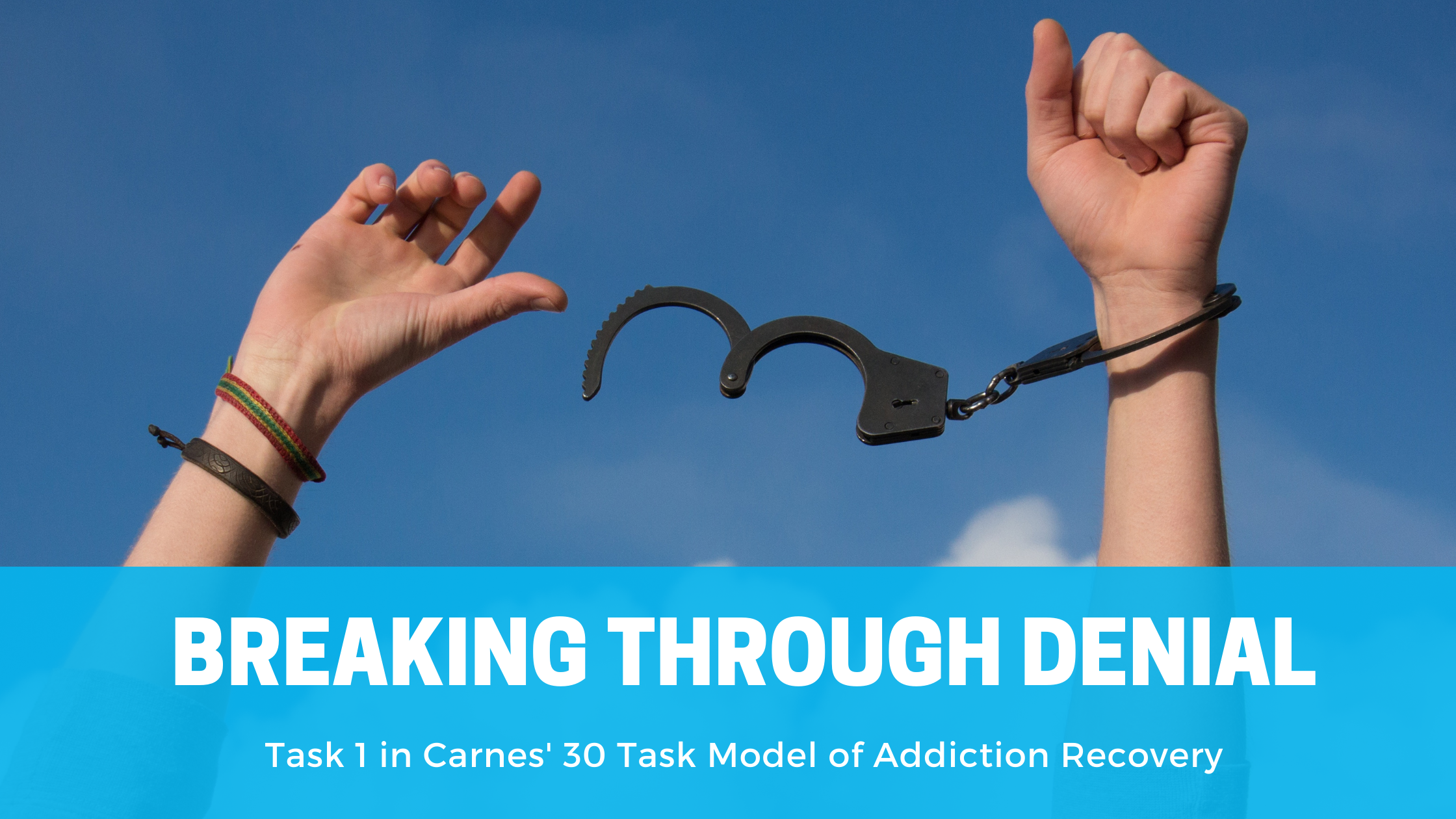What do you do after you realize you have a problem with sex and love addiction? Maybe you’ve been found out by a spouse or significant other, and you know you need to get help. Perhaps you’ve had legal or financial consequences that put you in a position to make some serious changes. You may have even begun therapy with a counselor to address your addictive behaviors. But what does treatment for sex and love addiction look like?
The 30 Task Model
Dr. Patrick Carnes, the pioneer in research and literature on sex addiction, designed his treatment model centered around 30 essential tasks to recovery. These 30 tasks are broken into three sections: early recovery tasks, long-term recovery tasks (internal and external), and relational/family recovery. He explores the first seven of these tasks in his workbook Facing the Shadow, while the next set of tasks is outlined in the follow-up books The Recovery Zone 1 & 2.
While all thirty of these tasks need to be addressed during the 3-5 year period of recovery from addiction, they aren’t necessarily completed in order. You may find yourself working on spirituality (task #30) while you’re in the early stages of learning more about addiction (task #2) and establishing sobriety (task #5). Or you may find that, several years into your recovery, you need to break through denial (task #1) about a new area of addiction that has replaced your sexual acting out (task #8). Or while you’re working on your marriage relationship (task #27), you’re also grieving the losses your addiction has created in your marriage (task #12).
The 30 tasks don’t directly correlate with the 12 Steps, they share much of the same DNA. For example, task #3 (surrender to the process) is very similar to what you’d find in Step 2 and Step 3. In fact, task #7 (participate in a culture of support) is implemented through involvement in support groups and 12 Step programs.
The 30 Task Model can give you a roadmap to follow in treatment for sex and love addiction. They can also be a helpful reference point when you’re in the middle of recovery and looking for what’s next or when you find yourself getting off track. I’ve used them in sessions with clients as a means to define our goals together and as a self-assessment to identify potential areas for continued growth.
In this series, we’ll take an in-depth look at each of the 30 tasks in Carnes’ model and explore some of his recommended activities (as well as a few of my own) for addressing this task or returning to it later in recovery. Kavod Psychotherapy created a reference diagram briefly describing each of these 30 tasks. More information on the tasks can be found in Facing the Shadow, The Recovery Zone series, or the Recovery Start Kit, all created by Dr. Patrick Carnes.
Task 1: Break Through Denial
The essential starting point for any addict in recovery is the shift in thinking from “I don’t have a problem” or “this isn’t a big deal” into facing the reality of the presence of addiction and its destructive power in your life.
To put the label of “addiction” on your behaviors can be challenging, as we often associate addiction with moral failure or flaws. Denial allows you to avoid a sense of shame or guilt about these behaviors. Labeling behaviors as addiction also compels you to change, while denial can justify or minimize the impact of your behaviors.
Often the first call to break through denial comes when a loved one, like a spouse, finds out about your compulsive sexual behaviors. This often begins the process of therapy and support. Sometimes you’ve experienced a sense of guilt or being unable to stop that you’ve been aware of, but there isn’t any motivation to make a change until you hit that crisis point.
Practical Steps for Task 1
Take an addiction-related assessment.
When you begin working with a Certified Sex Addiction Therapist (CSAT), they’ll typically encourage you to take one of a few different types of assessment to compare your symptoms and behaviors to a norm.
One is a quick inventory that you can take on your own: The Sexual Addiction Screening Test, or SAST. This compares responses from a non-addicted population to a population of self-reported sex addicts. This way, you can see whether or not you fall within range of normal behavior or addictive behavior.
If your scores from the SAST put you in range of addictive behavior, you may be asked by your therapist to take a Sexual Dependency Inventory (SDI). This is a much more extensive assessment that helps you clarify the form your addiction takes, as well as various additional measures that identify potential roots for the addiction. Some of the questions for this particular assessment are found in the Facing the Shadow book in Chapter 3, so you can review those on your own if you choose.
Another alternative is to compare your experience of compulsive sexual behaviors with the criteria for addiction listed in the DSM-5. While there isn’t yet a diagnostic category for sexual addiction in the DSM, you can use the same criteria as alcohol or drug use disorder and simply replace the substance listed in the criteria with compulsive sexual behaviors.
Write out any problems or consequences you’re experiencing.
Make a list of any problems you’re facing in your life, whether they are obviously addiction-related or not. Often problems seem unrelated to the addiction, but their solutions can be influenced by the time and energy the addiction takes.
Examine your list to identify which of these are either directly caused by or intensified by your compulsive sexual behaviors. Include not only physical consequences you may have had as a result of the addiction but also emotional and spiritual consequences.
Make a list of the secrets you are keeping and from whom you are keeping them.
Addiction thrives in secrecy. One major way to break through denial is to identify where that secrecy is taking place. This deception can be about major things, like hiding your compulsive sexual behaviors for fear of rejection or pain. But they can also be about minor things, like finding yourself compulsively lying or hiding aspects of who you are as a person.
Take note of these, as well as from whom you’ve been hiding them. Notice if there is anyone in your life who knows everything. If not, be curious about why that is. If you run into a pattern of presenting a different person in different contexts, explore what might be influencing that behavior.
Recognize the “stinkin’ thinkin’” of addiction.
Denial exists primarily in our minds as a way of interpreting our behaviors and our thoughts. It can show up as making excuses, minimizing, justifying, feelings of entitlement, blame-shifting, taking on the victim role, and many others.
Begin to recognize the beliefs you have that allow you to continue on in your addiction. Utilize resources such as this article to identify different types of beliefs that might show up in your denial.
Sometimes these beliefs are so strong that they’re hard to label as denial. Understanding delusion and self-deception can help make sense of these thoughts and place them into the correct category.
Tell the whole story to someone.
Once you’ve sorted through how denial functions to protect you from facing the reality of your addiction, now you can work against that denial by sharing your story of addiction with a safe and trusted person. This person could be your therapist, sponsor, pastor or spiritual mentor, or a close friend who has offered understanding and empathy when you’ve talked about difficult things in the past. It may be helpful to write a letter or narrative to help you express your thoughts and ensure that you are as honest as possible.
Many 12 Step programs encourage you to share this information in your First Step. You might share parts of your story with a group during a regular meeting or present your First Step as a whole to the group. Telling another sex and love addict in recovery can be helpful, particularly in a group setting. They will know how and when to challenge you, as they can relate to the experience in a unique way.
Obviously, it can be challenging to work up the courage to share your First Step with the group in a way that feels supportive and kind to yourself. Get connected to a sponsor or other support individual and share with them first before you do so in a more public form. In the meantime, listen to others’ First Steps to consider what pieces of your story relate to theirs.
Check your story with others.
The way we perceive the world, especially when it comes to our own actions, isn’t always the way others see it. If you’re wondering about the impact of your behaviors and you feel able or comfortable to do so, ask others. Similarly, you can observe when others in your group talk about the impact of their addiction on their loved ones and draw connections to how your loved ones may be feeling.
If you are married or in a significant relationship with another person, you may go through a formal disclosure process at some point. As part of the disclosure, your loved one will read you an impact letter they’ve written that describes how they have felt as a result of your addiction. This can be a helpful experience to come back to as a reminder of the reality of the pain caused by your behaviors.
Repeat.
Keep coming back to these components of breaking through denial at each stage of your recovery. You might find the stinkin’ thinkin’ re-emerges when you’re about to face a new challenge to your sobriety. At around 6-8 months of sobriety, you may become overconfident and observe some of these denial patterns coming back in again.
Create and add to a list of beliefs that push you into addiction, denial statements, entitlement, and excuse-making statements so you can continue to recognize those thought patterns when they come up. The more you are able to recognize and be on guard for this denial, the more likely you will be to catch it and redirect into your recovery.







